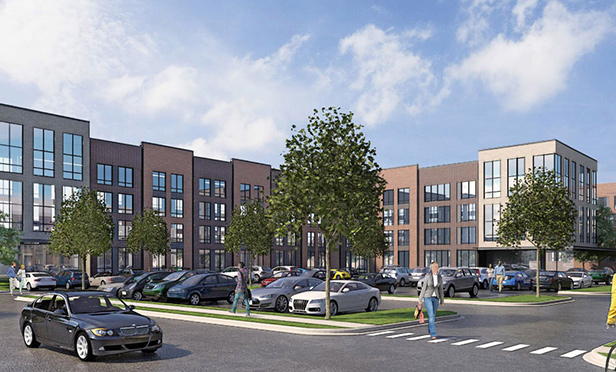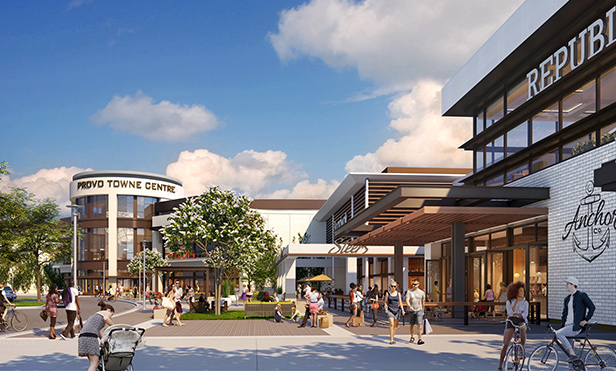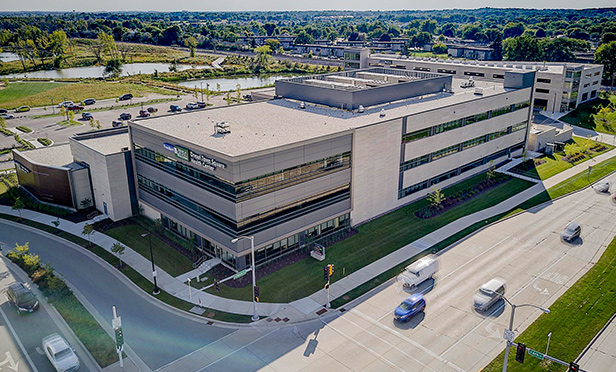 Rendering of Ogden Commons, Habitat Company's $200 million mixed-use project spanning 10 acres in Chicago's North Lawndale neighborhood
Rendering of Ogden Commons, Habitat Company's $200 million mixed-use project spanning 10 acres in Chicago's North Lawndale neighborhood
CHICAGO, IL—A strong US economy continued to fuel the commercial real estate market in 2018. And while the industry is expected to face headwinds in the form of rising interest rates, tightening credit and lingering uncertainty over the geopolitical climate, many commercial real estate experts remain bullish on the market going into the new year, particularly as the longer-term effects of tax reform come into focus.
“Interest rate movement will be front and center in 2019,” says Steven Weinstock, first vice president and regional manager of Marcus & Millichap's Chicago Oak Brook office and national director of the company's National Land Group. “As interest rates go up, we will see some cap rate decompression, particularly for income-producing properties locked into long-term leases without adequate rent bumps to keep pace with inflation and the rising cost of capital.”
With relatively clear skies on the horizon, here are six trends that will impact commercial real estate in 2019, according to some of the industry's leading Midwest experts.
Getting a Rise Out of Interest Rates
With three interest rate increases so far in 2018 and another forecast by year's end, industry experts already are looking ahead to 2019, when several more hikes are expected. Whether the Federal Reserve will follow through on its plan remains to be seen, but investors are mindful of the trend and, in many cases, have already begun structuring deals accordingly.
“We continue to see owners move to lock long-term rates as soon as assets qualify,” says Matt Wurtzebach, vice president with Draper and Kramer's Commercial Finance Group. “We also have seen an increased focus on provisions that a future buyer would find favorable if they assumed the in-place debt, including transfer and secondary financing rights. If you believe rates will increase, obtaining a good rate now with the right structure adds a lot of value above and beyond future interest rate savings.”
Faced with greater risk today than even a couple of years ago, some developers are getting into the lending and preferred equity business, says Steven “Sonny” Ginsberg, co-founder of Chicago-based real estate law firm Ginsberg Jacobs, whose expertise includes structuring complex debt and equity vehicles. “Developers can stay in their 'lane'—be it geographically or through asset class—while shielding themselves from part of the risk,” he said. “Because they've done similar projects before, they understand the developments better than anyone, and if needed, can step in and see the project through as the developer.”
Ginsberg believes, though, that despite real estate being a cyclical business, it's a far healthier and less risky business than it was a decade ago. And while there may be a slowdown, he doesn't expect a crash like 2008 thanks to more discretion on both sides of today's deals. “Lenders and borrowers who were burned the last time around are putting safeguards in place to ensure the same mistakes aren't repeated,” he says. “In the case of developers and investors, this means making more conservative projections in terms of rent or price growth.”
Opportunity in Opportunity Zones?
2019-20 may be “Gold Rush” years for the Opportunity Zone program, created by the 2017 Tax Cuts and Jobs Act to leverage private capital to improve distressed areas across the US—8,700 to be exact. But who will strike gold, and who will come up empty?
Under the program, investors can invest unrealized capital gains in an Opportunity Fund that in turn finances residential or commercial development, or even business enterprises, within the designated Opportunity Zone census tracts. The longer investors leave their money in the fund, the more tax forgiveness they get.
“Opportunity Zones have the potential to pump equity into distressed communities with less risk than existed before the funds were created,” says Charlton Hamer, senior vice president of Habitat Affordable Group, the affordable housing division of The Habitat Company. Habitat is developing Ogden Commons, a $200 million mixed-use project spanning 10 acres in Chicago's North Lawndale neighborhood, within one of 133 Opportunity Zones within Chicago city limits.
Yet some uncertainty about the program remains nearly a year after it was introduced, according to Weinstock of Marcus & Millichap.
“I think a lot of people are going to flock to Opportunity Zones in 2019 – and there are already investment funds established with billions of dollars—but the picture is much less clear than everybody wants it to be,” Weinstock says. “Recently released guidelines from the IRS and Treasury Department have given investors a better understanding of the program, but many questions still remain. Simply, does the Opportunity Zone, factoring in the initial acquisition cost, additional funds required and potential capital gains savings, produce a desirable return such that investors will move their money into these areas?”
With so much capital sitting on the sidelines, some experts question whether there are enough deals available within the designated areas.
“On the surface, Opportunity Zones look like a no-brainer,” says Sonny Ginsberg. “The question is, will there be enough opportunity to utilize all the money being raised in a wise manner? And if not, what will the funds do with leftover capital? Investors expecting a gain deferral until 2026 will not want returned funds in 2019 and 2020, and the regs are not yet clear as to whether investors can reinvest returned capital into another Opportunity Zone should any funds be returned.”
Larry Bond, co-founder and chairman of Bond Companies, which is establishing a project-specific Opportunity Zone Fund for a development in Los Angeles, cautions there are also concerns regarding the impact these funds will have on the communities they are meant to serve in terms of gentrification. He urges interested investors to consider the experience a fund manager has in these types of developments.
“Investing in funds that have defined projects being handled by developers who are experienced in the market is key,” says Bond. “Developers who have a track record of completing projects in partnership with neighborhood groups and other community stakeholders often have the relationships and trust needed to make projects successful.”
Out of the Big-Box
Big-box stores don't fit very well in today's real estate landscape. As e-commerce accounts for a greater share of total retail sales, traditional retailers have closed many underperforming stores in markets across the country. Some established brands, including Toys “R” Us and Bon-Ton, have disappeared entirely, leaving behind cavernous spaces that have developers and investors asking, “What do we do with all that empty space?”
“We've worked on several projects that involved dividing vacant big-box stores into three or four smaller tenant spaces ready for build-out,” says Chuck Taylor, director of operations for commercial contractor Englewood Construction. “While no one wants to see the doors of a big-box store close, there are windows of opportunity opening. The modified property can be marketed to an entirely new group of potential tenants looking for a smaller square footage range than is typically available in a well-established power center.”
In some cases, vacancies are being filled with alternative uses that make sense in established retail locations, according to experts.
“Clearly, the former boxes are taking many paths,” says Richard Tucker, CEO of Tucker Development. “Some have new retailers occupying all or part of the space, and in other examples, the buildings and parking lots are being transformed into other uses such as entertainment, office and residential. Each location is unique, but typically the more urban and dense a site is, the more opportunity there is to create value.”
A new flexibility around co-tenancy clauses is making such transformations possible, according to Michele Krause, an attorney with Ginsberg Jacobs. This allows landlords to fill empty big-box and department spaces with once-restricted uses, such as grocery stores and exercise facilities.
“Tenants that would have enforced co-tenancy clauses are more willing to negotiate because they realize it's better to work together to keep the lights on,” Krause says.
 Provo Town Centre, Provo, UT
Provo Town Centre, Provo, UTDramatic changes in retail are making some owners and developers re-envision entire shopping centers. KTGY Architecture + Planning was recently tapped to refresh Provo Towne Centre, a 20-year-old enclosed shopping center in Provo, UT.
“Our team deconstructed the big-box, creating four to six unique restaurants and retail spaces, and added residential, office and entertainment spaces,” says Simon Perkowitz, principal at KTGY. “The new shops and restaurants are adjacent to a new landscaped plaza, creating a connection to the center's main entrance rotunda that is redesigned to maximize the views from the entry and second-level food court to the mountains and sky. With projects of this sort, it is essential to 'think outside the big-box' and foster a sense of community for the people who come here.”
People continue to go to stores to get the kinds of experiences they can't get online, says Jeff Berta, senior director of real estate for Structured Development. Earlier this year, the Chicago-based firm secured a lease with climbing gym Planet Granite at The Shops at Big Deahl, a 500,000-square-foot mixed-use center in Chicago's Lincoln Park neighborhood that's scheduled to break ground in spring 2019. Structured also was recently chosen to develop the remaining parcels in a larger 27-acre master plan in Orland Park, IL. Working in collaboration with village officials, the firm envisions a pedestrian-friendly, urban-inspired live/work/play district with residential and commercial uses, including retail. “We are not focused on big-box retailers as our project is a pedestrian-friendly, downtown-inspired mixed-use project with smaller-footprint shops,” says Berta.
Retail Revival
Big-box retail may be struggling, but bricks-and-mortar retail is not dying; in fact, it's not even ill, according to some industry experts. Retail sales—excluding automobiles, gas stations and restaurants—have grown year-over-year in all but one month since the beginning of 2010, according to the National Retail Federation, which revised its 2018 sales forecast upward, to a growth rate of 4.5 percent, earlier this year. Moreover, a report from global research and advisory firm IHL Group found that for every retailer closing stores in 2018, two are opening locations, resulting in net growth of over 2,000.
“Many online retailers are moving into brick-and-mortar, which shows how it's not an either/or decision for many brands; instead, they want both,” says Marcus & Millichap's Weinstock.
“Amazon's expansion into traditional storefronts with cutting-edge technology is an example of how the old model is being modified rather than replaced,” he says. “But the basic fundamentals of the real estate, including location, remain largely unchanged.”
When e-commerce retailers do establish a brick-and-mortar presence, many are looking at smaller locations that function mostly as showrooms. Purchases are then shipped to the customer's home using regular distribution channels, reducing the need for in-store inventory, according to experts.
“Most of these spaces are pretty small, around 800 square feet, and are often more about promoting the brand than selling a specific product,” says Chuck Taylor of Englewood Construction. “Even though they aren't leasing much space, these brands are so popular and powerful in driving foot traffic that landlords are eager to court them. As a result, many tenants are able to negotiate concessions, such as the buildout of their space.”
Supersized Warehouses
The shrinking retail store size is giving rise to the super-sized warehouse, increasingly used by e-commerce retailers to fulfill orders placed online—often the same or following day.
“Mega-warehouses enable e-commerce companies to cut their costs by putting inventory in storage rather than in stores, and by being closer to customers, thereby reducing transportation costs,” says Ken Szady, national director and senior leader of Marcus & Millichap's Institutional Property Advisors Division for North America and Canada. “The ability to automate portions of the pick-and-pack process—essential to the utility of these bigger facilities—also helps generate long-term savings.”
 HSA's Heartland Corporate Center, under construction in Shorewood, IL
HSA's Heartland Corporate Center, under construction in Shorewood, ILDeveloper HSA Commercial Real Estate's latest industrial project, a 757,880-square-foot warehouse in Shorewood, IL, that will deliver in early 2019, underscores not only tenant demand for large vacancies, but also the overall health of the industrial market amid record-low vacancy. Like many projects these days, the HSA development, known as the Heartland Corporate Center, is being built “on spec.”
“The industrial market's appetite for quality distribution centers to meet increasing last-mile demand is growing stronger,” says Robert Smietana, vice chairman and CEO of HSA Commercial Real Estate. “Higher clear heights, additional truck docks, abundant secured trailer storage and the ability to introduce technologically advanced equipment are becoming the norm across the board.”
Wellness Goes to Work
While part of the commercial real estate lexicon for years, wellness has grown into a $4.2 trillion global business that is expanding at nearly twice the rate of the global economy. After all, people who practice yoga, eat organic foods, and seek out things like sulfate-free, paraben-free, formaldehyde-free shampoo certainly don't want to work in unhealthy offices.
Through participation in programs like the Well Building Standard and Fitwel, newly constructed and renovated office buildings are catering to wellness-minded employers who increasingly view their space as a recruiting tool. For businesses, the benefits of WELL and Fitwel certification are twofold: they aid in recruiting, and they also help the bottom line by lowering employee healthcare costs, reducing absenteeism and boosting productivity, experts say.
“Companies pay quite a bit of attention to employee benefits, which typically run about 20 percent of corporate costs, but what makes people truly more productive and happy is working in a healthy building,” says John Mlade, senior project manager, sustainable and healthy environments, at Wight & Company, a Chicago-based design and delivery firm whose expertise includes sustainable design. “Access to natural light and views of the outdoors consistently rank among the most-requested in-office amenities, and their inclusion starts with thoughtful design – everything from the positioning of workspaces to use of materials such as translucent glass that provides privacy without sacrificing light.”
 Drexel Town Square Center, Oak Creek, WI
Drexel Town Square Center, Oak Creek, WIMedical providers also are increasingly looking to tap into the wellness trend. For example, Drexel Town Square Health Center, a 109,000-square-foot medical office building developed by HSA PrimeCare, is connected to a public walking path so patients and employees can incorporate exercise into their daily routine.
“Tech-savvy millennials are driving a lot of the wellness features that will continue to permeate healthcare design in the coming year,” says John Wilson, president of HSA PrimeCare. “With providers and consumers increasingly focused on preventive care, we're starting to see that reflected in real estate. For example, millennials have embraced wearable tech that provides incentive to log activity and make their daily steps, and MOB providers have responded by incorporating features such as a walking path near the facility or a fitness center within it.”
© 2025 ALM Global, LLC, All Rights Reserved. Request academic re-use from www.copyright.com. All other uses, submit a request to [email protected]. For more information visit Asset & Logo Licensing.








